


Saturday, September 20, 2008 at 8:00 p.m.
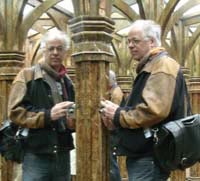 "Even those of us fiercely devoted to the field of experimental cinema know
all too well that it can be rather humor-impaired ... No surprise, then,
that a stealth anarchist like Grenier is like a breath of fresh air." -
Michael Sicinski (GreenCine)
"Even those of us fiercely devoted to the field of experimental cinema know
all too well that it can be rather humor-impaired ... No surprise, then,
that a stealth anarchist like Grenier is like a breath of fresh air." -
Michael Sicinski (GreenCine)
Hallwalls' Media Arts Program will kick off its Fall 2008 Season with a
retrospective of Avant-Garde filmmaker Vincent Grenier.
For over 30 years the French-Canadian artist has been creating award-winning
experimental films and videos, yet his last visit to Buffalo was over three
decades ago! Hallwalls is proud to welcome this esteemed filmmaker back
to Buffalo. Grenier will present an evening of his poetic and abstract films
and videos, a survey which will range from his early 16mm films to his most
recent video projects including: Tabula Rasa (1993-2004, Orig.16
mm/DV, 7:30 min., color, sound); Catch (1975, 16mm, 5 min. color/silent);
Here (2002, DV, 7:00 min. stereo); Surface Tension #2
(1995, 16mm, 4min., color, optical mono); North Southernly (2005,
6 min. color stereo); This, and This (2006 DV, 10:30, min., color,
stereo); Mend (1979, 16mm, 5 min. B&W/silent); Armoire
(2007, DV, 3 min., color, stereo); Interieur/Interiors (To AK)
(1978, 16mm, 15 min. B&W silent).
Grenier's earliest film efforts received critical acclaim within the world
of experimental cinema, with the likes of pioneer Jonas Mekas paying close
attention to his aesthetic: "There is a seriousness, consistency and persistency
about his work that is more than impressive." (The Soho Weekly News,
1976). Not unlike film art luminaries such as Stan Brakhage, Grenier's work
engages the fundamental questions of film art, namely how cinema uses light
and shadow, space and time, color and shape, sound and image. "Since his
very first films," writes Nicole Gingras of Montréal, "Grenier focuses
his interest on the simple gestures of the everyday. To dissolve the abstraction,
to draw one's attention on the minute details which when filmed, become
very poetic and reveal the individual behind the mechanical and the routine…"
(La revue de la Cinémathèque, 1991). Regarding Grenier's
presentation of his film Interieur/lnteriors (1978) at the Albright-Knox
Art Gallery in 1979, Anthony Bannon writes, "If about anything other than
their own existence, Grenier's films are about other art—at best,
about information," thus locating his work more in the world of abstract
art than in representational film. Although steeped in the art making traditions
of celluloid, Grenier's embrace of video as a tool positions him along side
venerable filmmaker and fellow Canadian Michael Snow, who has never pledged
an unyeilding fidelity to a given medium such as film. Since 1990, Grenier
has used video technologies as a way to further his experiments in time-based
media. "In many of my recent digital video works, I have experimented with
color, sound and composition as expressions of cultural assumptions, in
addition to, being expressions of phenomenological, visual or psychological
events," he writes. "Through sound image juxtapositions, digital manipulation
and layering, my work attempts to deal at once with the propensity to mislead
and eloquence of the recorded image. Images and sounds are chosen because
of their potential for this kind of interaction. Paying close attention
to a re-mix of the artifacts, camera recordings make, I am particularly
interested in re-contextualizing or at least rescue received ideas in the
way formal structures and meanings have traditionally been created."
A full bio as well as further details about the works that will be screened
follows; for more information please visit the artist's website: bingweb.binghamton.edu/~vgrenier
BIO
Vincent Grenier was born in Québec City, Canada. He has lived largely
in the U.S.—mostly New York City. In spite of this, he was a frequent
contributor to the Montreal Art scene of the 70's and 80's as well as the
SF bay areas in the early 70's. He has made experimental films since the
early seventies when he received an MFA at the San Francisco Art Institute
in California. Grenier's films have been shown in the United States, Canada
and Europe at showcases such as the Museum of Modern Art in NYC, the Anthology
Film Archives, the Pacific Film Archives, the Collective for Living Cinema
and Cinéma Parallel in Montréal. His films and videos have
earned him production grants from the Canada Council, and in New York State,
from CAPS, NYFA, and ETC. He has made over two dozen films and more recently
videos, such as TABULA RASA (7.5 min. 2004), 2nd prize Media City
Festival, Windsor, Canada; Views from the Avant Garde, New York Film Festival
and Onion Film & Video Festival, HERE (6.5 min, 2002) Awarded
Gold for best Experimental film, New York Film Expo, COLOR STUDY
(4.5 min, 2000) Rotterdam Film festival, London and Toronto Film Festivals
, Lincoln Center, Second prize at the Black Maria Film Festival and MATERIAL
INCIDENTS, (6 min. 2001), Rotterdam Film Festival & New York Video
Festival, FEET (27 min., video, 1994) won second prize at the 1995
Black Maria Festival and was shown in the WNET series Reel NY. His films
include: OUT IN THE GARDEN (1991)--Best Documentary, 1992 Ann Arbor
Film Festival, Best Experimental Documentary, 16th Atlanta Film/Video Festival,
shown on WNET and London Film Festival; YOU (1990)--Black Maria Festival;
TIME'S WAKE--(1987) Prize Winner Black Maria Festival; INTERIEUR/INTERIORS
(1978)--Prize Winner, San Francisco Are institute Film Festival; WORLD
IN FOCUS (1976) Second Prize Winner, Ann Arbor Film Festival; and WINDOW
WIND CHIMES (1974)--Prize Winner, Bellevue Film Festival in Oregon.
Seven of his films ∧ videos were curated in the Whitney Museum of American
Art 1970-2000 American Century Film program. Films by Grenier are included
in the Donell media library in NYC, the National Film Archive, Ottawa, the
National Gallery of Canada, Ottawa, AGO, Toronto and at many other institutions
in Canada and the US. Grenier teaches in the Cinema Department at Binghamton
University and Lives in Ithaca, New York.
PROGRAM
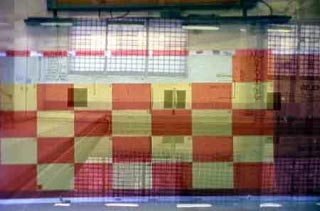 Tabula Rasa (1993-2004, Orig.16 mm/DV, 7:30 min.,
color, sound)
Tabula Rasa (1993-2004, Orig.16 mm/DV, 7:30 min.,
color, sound)
Filmed in a South Bronx high school, Tabula Rasa attempts through
sound image juxtapositions, digital manipulation and layering to deal at
once with the propensity to mislead and eloquence of the recorded image.
The ambiguous qualities of appearances, so assiduously cultivated by institutions,
the motivations found in the clues that tells the history of objects, colors,
textures, architecture and ultimately, psychological states of mind are
but some of the players in this poetic and cultural happening. All the material
for this digital video was initially shot on 16 mm film, in June of 1993,
thanks to a grant from the Canada Council. We hear the voices of mediation
counselor Victor Hall and student John Cruz. The filming would not have
been possible without the help of an extraordinary teacher Dan Sheehan.
"Verbal descriptions of fictional comic book characters are interwoven with
elegant abstracted shots of a South Bronx high school's walls and corridors
(which according to the filmmaker is an '...attempt to sort through and
take to task the enormity of that institution... to engage in a real discourse...with
the clues that tell the history of objects, colors, texture, architecture
and ultimately, psychological states of mind that are but some of the players
...'). A possible undercover study on institutional formatting of minds
not yet affected by experiences." Black Maria Film Festival
Catch (1975, 16mm, 5 min. color/silent)
"Catch is a fragmented observation on hidden reflective surfaces,
the corner of a dormant television screen, a window…" -Mike Reynolds, Berkeley
Barb
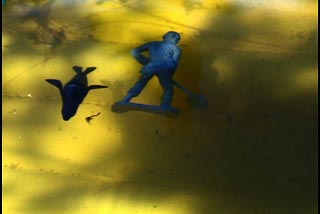 Here (2002, DV, 7:00 min. stereo)
Here (2002, DV, 7:00 min. stereo)
A boy's phantasmagoric world of heroes is captured in layers of light and
hues. This video, humorously and poetically juggles ideas about make believe
and representation of the everyday.
"Here plays as some form of synthetic/organic haiku or renga (Japanese linked
poetry) linking semblance to semblance working with the primal power and
suggestiveness of transient colors. A shift in hue argues for motion or
cessation—stop and go. Migrant juices of color change aspect—blood,
fire, rain, red leaves living and dead. Green plastic soldiers float lifelessly
in autumnal pools of septic yellow. Simple magic. Simple prophesy. Child's
play augurs global events and as in Rimbaud's Le Bateau Ivre a
patch of backyard here becomes a primeval forest of decaying moss a beachhead
and the abandoned frontline, a field of fire as a tableaux mort."
- Mark McElhatten, Turino Film Festival Screening Notes.
Surface Tension #2 (1995, 16 mm, 4min., color,
optical mono)
This film was shot in color but using the Kinemacolor process, a process
which was used in 1915 to obtain fairly illusionistic colors from black
and white films by filming and projecting them through synchronized red
and green filters. Director's Choice, 1995 Black Maria Film & Video Festival
North Southernly (2005, 6 min. color stereo)
Changes of directions, in the wind, the edges, the shapes, a joyous and
mesmerizing intrigue. Perhaps an other way to put it is to describe this
piece as a humorous digital cine take on the long cultural history of the
lessons left by the great Chinese painters of the 13th century for whom
shapes and edges where often all one and the same. On North Southernly's
use of sound Grenier writes: "One of my interest in choosing and editing
the sound for this video was in its use as cultural reference, one that
would bring different (hopefully humorous) readings of the unfolding images.
The painterly and exalted nature of the video images, while unique, is part
of the same cultural history as the musical quotations used in John Cage's
piece. He also felt moved to challenge the tonal musical world of his predecessors
by treating their music as rhythmic material for his percussive project."
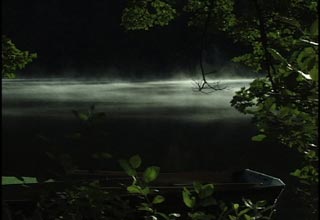 This, and This (2006 DV, 10:30, min., color, stereo),
This, and This (2006 DV, 10:30, min., color, stereo),
"...Vincent Grenier is an artist whose shift to digital filmmaking has consistently
been characterized by a rigorous investigation of the specific aesthetics
and formal parameters of his adopted medium. This, and This is
no exception. Thematically, Grenier's piece is a conversation with nature
in both its raw and culturally mediated forms—for example, the rushing
waters from Ithaca Falls juxtaposed with the spray of a rain puddle traversed
by a steel belted radial. The piece is in many ways a meditation on the
power of the straight cut, as opposed to the fades and image-alternations
so common in recent video work. As the video progresses, Grenier implies
that non-mediation doesn't exist. But on an even more basic level, This,
and This pits vertical against horizontal movement, as well as pushing
digital video to the limits of its comfort zones, as swirling forms begin
to pixilate or produce visual feedback. Grenier's medium is indeed the lion's
share of his message." … New York Dispatch.11 Michael Scinski on
the new works shown at the 10th annual Views from the Avant Garde, a presentation
of the New York Film Festival
Mend (1979, 16mm, 5 min. B&W / silent)
Is it happening in the screening room or on the screen; in a snowstorm or
inside; what isn't surrounding and what is? From filming Ann sewing, on
a grey winter day.
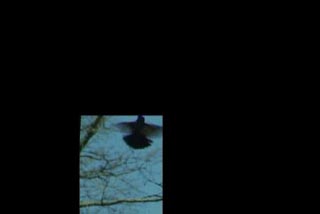 Armoire (2007, DV, 3 min., color, stereo)
Armoire (2007, DV, 3 min., color, stereo)
It was all started by a Red Robin who one day in the spring, obsessively
went after his double in the large mirror at the end of our garden. It became
a strange revisiting of the framed image's shape/s and behavior. After my
earlier film Light Shaft. Just having fun with the surrounding
consequences regarding storage, openings, motion and nature among others.
"The secret might have been the unassuming wonder of Vincent Grenier's Armoire,
a film in which a small bird expands the edges of the frame by hopping and
fluttering about. As the frame responds to his light, unpredictable movements,
it is at times rushing sideways or holding still, shrinking and stretched
in every imaginable permutation. And yet the frame doesn't always manage
to capture or contain the bird, who in the end darts out of sight. It is
as if he is the true filmmaker, directing the scene and, with his own star
exit, deciding when to cut." -- Genevieve Yue in SENSES OF CINEMA, Observation
in Progress, Views from the Avant Garde, 45th New York Film Festival.
Interieur/Interiors (To AK) (1978, 16mm, 15 min.
B&W silent)
"Emptying out not only referential space, but the referentiality of space
is in part the project of Vincent Grenier's film Interieur/lnteriors
(1978). The film's title transposes the opposition interior/exterior to
one between connotations of interior in two languages and between singularity
and plurality. The title suggests shifting ar chitectural interior spaces,
while maintaining the more philosophical, psychoanalytical and literary
connotations of the French, intérieur, as that which occurs
dans I'esprit, along with the specific notion of a tableau
d'intérieur, familial genre painting. ... As this film unfolds
we experience this duality as a coming and going of differ ent indices and
activities that might clarify this space. What appears to be a white wall
is initially marked only with a vertical line on the left, but then a parallel
line on the right appears to define a space behind this wall, more grey
in tone, whose depth is hinted at by the movement of a partial figure (a
sleeve?) within it. Then, for a moment, a shadow dominates the central space,
until a large hand pulls what is clearly a string (formerly just the line
on the left) which "causes" the stripe on the right to become black, as
if this string controlled a light in the interior of a room on the right.
This event then gives way to another as the "string" becomes a gap indicating
a door opening through the mid-section; the film continues in this way to
create ambiguous interior that later return to a surface flatness, while
at moments the image appears to be closer to a book whose pages are being
turned than to the space of even the most illusive of rooms."
- From The Displacement of Architecture in Avant Garde Cinema by
Maureen Turim
Some publications related to this event: September, 2008 - 2008
September, 2008 - 2008